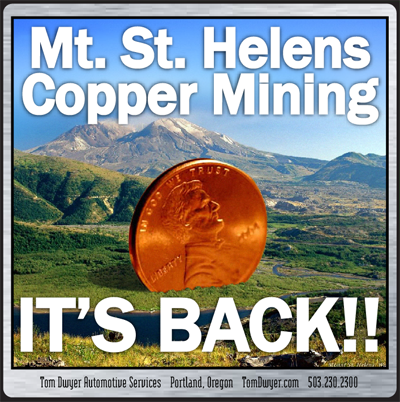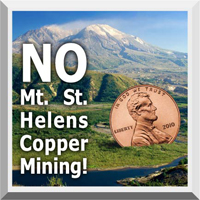Copper Mining in Mt. St. Helens… It’s BACK!!!

 In 2012 we were Furious that Mt. St. Helens was the target for exploratory mining. In 2014 there seemed to be reason to calm down when a Federal District Court ruled that federal agencies’ approval of the mining application violated numerous environmental laws and the project was canned. Now a new President means another bite at the apple for the miners, and this year the Forest Service gave consent for exploratory mining to go ahead in the Green River Valley bordering the Mt. St. Helens Volcanic Monument. Read this article from The Columbian laying out the current environmental insult, then check out our article from 2012 below. Yes, you’ll be Furious when you learn all the details, but you’ll be even more outraged when you see how little has changed since this first became an issue.
In 2012 we were Furious that Mt. St. Helens was the target for exploratory mining. In 2014 there seemed to be reason to calm down when a Federal District Court ruled that federal agencies’ approval of the mining application violated numerous environmental laws and the project was canned. Now a new President means another bite at the apple for the miners, and this year the Forest Service gave consent for exploratory mining to go ahead in the Green River Valley bordering the Mt. St. Helens Volcanic Monument. Read this article from The Columbian laying out the current environmental insult, then check out our article from 2012 below. Yes, you’ll be Furious when you learn all the details, but you’ll be even more outraged when you see how little has changed since this first became an issue.
(If being Furious makes you want to be Active, we’ve provided links in the article to the group fighting the project… yet again.)

News To Make You Furious- Copper mining at Mt. St. Helens?
(originally published July 9, 2012 in Your Car Matters, the Tom Dwyer Automotive Services Newsletter)
Some things that make us Furious are loud and obvious, but others evolve quietly behind the scenes until it’s too late to do anything about them. This is a story about a quiet thing happening right now… an exploratory drilling request that could lead to an open pit leach mine near Goat Mountain, 11 miles from the crater of Mount St. Helens. Unlike so many Furious stories, though, this isn’t a “done deal” yet so the story is also about what you can do to help stop it…

Click here for our KPOJ radio spot on the original Mt. St. Helens mine proposal
At 8:32 on May 18, 1980, Mount St. Helens exploded in an eruption that lasted 9 hours and decimated the surrounding landscape. In 1982 the President and Congress created a 110,000-acre National Volcanic Monument around Mt. St. Helens and within the Gifford Pinchot National Forest, preserving the area for research, recreation, and education. Inside the Monument, the environment was left to respond naturally to the disturbance. However, when the Monument was created there was some question about the mineral rights of a small section of land near Goat Mountain that borders on the monument area. Rather than hold up the whole process to clear up this little glitch, the government went ahead with protecting the rest of the area, but left out this controversial little bit. After all, what could possibly go wrong?
In 2005, Idaho General Mines (now called General Moly, Inc.) stepped in to answer that question. They owned a 50% interest in the mineral rights, and wanted to start digging. After 3 years and 33,000 public comments (the majority of which were against the mining) the Bureau of Land Management (BLM) issued a “no decision”, stopping Idaho General but leaving the door open to other companies in the future.
It seems the future is now. Ascot Resources is a Canadian company that now owns the mineral rights to that odd bit of land, and they want to start exploratory drilling for copper, molybdenum, and gold. If they do decide there’s enough “gold in them thar hills” to make it worthwhile to mine, they aren’t large enough to do the work themselves. They would most likely sell (or sublet) their interest to one of the large global mining companies to develop the claim, and that’s when the trouble really starts…
- The mine would be approximately 3000 acres, directly bordering the legendary Mount St. Helens monument area.
- No matter what company takes over the claim, they would not be bound by any agreements Ascot made in their exploratory claim.
- Under the Mining Act of 1872 they can take the minerals while paying very little (if any) royalties to the US.
- Because the mine would be located in an active volcano, deep-shaft mining is out of the question. The only viable technology would be open-pit leach mining, which uses cyanide to separate the ore from the waste.
- The mine would threaten the watershed that supplies Kelso, Longview, and other smaller communities with clean drinking water.
- Since the penalties for not remediating the area are dwarfed by the profits from the royalty-free ore, there is little incentive to actually stay and restore the area’s environment after the mine is closed.
- Not surprisingly, one of the benefits used to sell the potential of the project is the number of jobs it would create. While glossy brochures distributed to area residents promised thousands of jobs for the life of the mine, other sources have estimated that 200 is a more likely number. In fact, company employees are quoted in the Longview Daily News saying only 18 jobs would be created for the actual drilling, one third of which have been promised to Canadian citizens. Also, the typical lifetime of a mine isn’t what it used to be. Mines used to be 20-30 year endeavors but now they’re used up after just 3-5 years.
- The mine would affect ancient forests, recreation areas, the Tumwater Inventory Roadless Area, and the entire Green River valley.
If Ascot completes the exploratory drilling they’ll have to apply for a permit for actual mine development, which would trigger an environmental review at that point. However, by investing time, money, and resources into this mining proposal now, the federal government is creating momentum that will be difficult to stop when it comes time to decide whether or not to permit actual mine development.

Click here to connect with the Cascade Forest Conservancy; formerly the Gifford Pinchot Task Force
But like we said, this is different than our usual Furious stories because it’s not too late, and you can still do something about this beyond grumbling.
The Gifford Pinchot Task Force was formed in 1985 to monitor timber sales and advocate for the Gifford Pinchot National Forest. Since then they’ve expanded their mission to support biological diversity and sustainable forest policy throughout the Northwest. The Task Force was instrumental in defeating the 2005 attempt to mine the area, resulting in BLM’s “no decision” in 2008. They’re taking the lead once again in this fight, and if mining at Mt. St. Helens matters to you then they need your help. Please consider helping financially, by donating your time, or by writing a letter opposing the exploratory drilling. If you’re interested, here’s how you can reach them:
(Edit 3/21/18- In 2016 the Gifford Pinchot Task Force changed its name to the Cascade Forest Conservancy. The info below has been corrected appropriately)
Matt Little, Executive Director, Cascade Forest Conservancy
mlittle@cascadeforest.org
4506 SE Belmont Street, Suite 230A, Portland, OR 97215
503-222-0055 www.cascadeforest.org
We talk about a lot of stuff in “Furious”… slavery, tax policy, nuclear energy, business and governmental abuses, and much more. The most infuriating thing about most of these stories is that the issues are too big or it’s too late to do anything about them, but this one’s different. Yes, it’s a big issue, and yes, it’s an uphill battle against moneyed interests. But IT CAN BE STOPPED, and most importantly, YOU CAN HELP! Please, call Bob at the GP Task Force and get involved… don’t let this treasure of our Northwest paradise be scarred forever for a short term gain!










